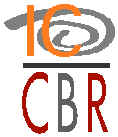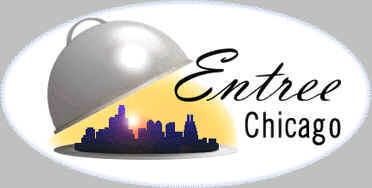|
| There then followed what for me was the best application paper of the conference by William Cheetham of GE. The application was the retrieval and adaptation of colour formulas for plastics. The beauty of this application was people performed it in a clearly case-based way. The CBR application was able to improve on their performance by being more objective. Moreover, it used fuzzy logic to perform the similarity assessment clearly demonstrating that CBR is an approach to problem solving and not a technology per se. |  |
 |
Hideo Shimazu of NEC gave a report of NEC's experience of developing CBR applications. It was interesting to hear that the SQUAD system is no longer being used, but that because its case-base was held in a proprietary DBMS the case data is still available to the company. Lessons for us all there. NEC's Help Desk Builder was also described and Hideo told the conference that he could provide the software to people who asked for it. |
| The first morning concluded with a talk entitled "New Technology Bliss and Pain in a Large Customer Service Centre" presented by Helen Thomas of Thompson Consumer Electronics. This gave a fascinating insight into the difficulties of successfully fielding a case-based help desk application. The technology is not even half the problem. People and politics were significant factors in the development of the systems she described. She talked about the problems of implementing systems to help "non-technical people solve technical problems for non-technical people" and she introduced the "mail room test". This involves grabbing a stranger who is sorting mail from the mail room and asking them to use your CBR system, If they can, you've succeeded, if not its back to the drawing board! |  |
Edwina Rissland enjoying the New England sunshine with Kevin Ashley |
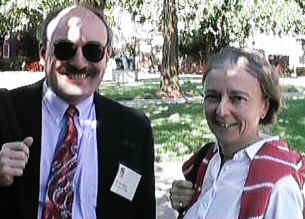 |
The afternoon had the theme of Issues and Methods for Large-Scale CBR. The first presentation was by Edwina Rissland about a hybrid CBR and Information Retrieval system called SPIRE. One of the pleasures of attending and event such as ICCBR is being able to see people, such as Edwina, who have been so influential in the development of CBR. Edwina is an excellent speaker and the system she described was very elegant. Details of this work (and more) can be found at the The Case-Based Reasoning Group's web site at the University of Massachusetts at Amherst. |
| David Aha introduced a new term to me - conversational CBR (Did you coin this term David?). This does not describe ICCBR delegates in the bar in the evening, but describes the iterative process systems such as CBR3 and CaseAdvisor use. David has featured prominently at both ICCBRs. His extensive knowledge of the ML/CBR literature keeps presenters on their toes. If you have overlooked an important reference he may even have a copy on hand to give you! Seriously though, David's thoroughness and enthusiasm does CBR a great service. His Machine Learning and Case-Based Reasoning Home Pages provide an excellent web resource. A copy of David's paper "Refining Conversational Case Libraries" is available for downloading. |  |
David Aha tormenting a grad student with his lap top and computerised bibliography of ML/CBR research papers |
The afternoon was rounded off by a panel discussion with the topic "Setting a CBR Research Agenda: Needs from Industry." This was chaired by Philip Klahr of Inference Corporation and the panelists were:
David Aha Naval Research Laboratories
Hideo Shimazu NEC
Ian Watson AI-CBR, University of Salford
Stefan Wess tecInno
Since I was on the panel I can't really give an idea of what the audience thought. There was however a deal of agreement between panelists on issues such as integrating CBR with mainstream DBMS systems, the importance of the web, and the need to develop simple commercial applications before tackling more challenging ones.
The panel session closed at 5.30 p.m., but this was not the end of the day. A reception with food and drink was held in the impressive Sayles Hall where poster presentations were conducted until about 10.00pm. Then (it still being so early) it was off to a bar with some colleagues. The Trinity Brew House in downtown Providence was chosen as an interesting example of the US phenomena of micro-breweries (very small independent breweries). Well, as a connoisseur of English bitter (i.e., I drink large quantities), I have to say that the Americans have all the proper ingredients but not the finesse of most English beers. The Hefe wheat beer was very nice though, but perhaps that's because my palate is not so familiar with this German style of beer.
| Day two opened bright and early (too early for some of us) with the start of the technical sessions and the broad them of Indexing and Retrieval. From the morning the paper that made the strongest impression on me was presented by Padraig Cunningham entitled "Using Introspective Learning to Improve Retrieval in CBR: A Case Study in Air Traffic Control". There is a specific quality to the work from Trinity College Dublin that I admire and that I wish more presenters would emulate. What I find when I listen to the Irish CBR people (Mark Keane, Barry Smyth, Padraig Cunningham, Kathleen Hanney, et al.) is that they have really thought about what they want the audience to learn from their work. I find when I listen to them not only do I understand what they have done, but I come away thinking "hey, I could use that technique". The work presented was about an introspective feedback mechanism that could optimise local feature weights for a nearest neighbour retrieval algorithm. |
 |
The morning concluded with perhaps the most talked about presentation of the conference. An invited talk called "CBR and Information Management: Lessons from the Info Lab" by Kristian Hammond. Let's be honest; Kristian is an excellent speaker. A rumour circulating the conference was that he performs stand-up comedy as a hobby. This might well be true as he certainly made the audience laugh. "Ah....but where was the technical content" some critics said. Not that he needs any introduction to most of us: Kristian was a student of Roger Schank and wrote the CHEF system. He now runs the Intelligent Information Lab at the University of Chicago. In their words "the Info Lab is driven by the desire to not only develop new ideas, but also to facilitate the transfer of these ideas into working systems. While the Lab is not concerned with producing applications for the commercial world, it is focused on the problems of information management that the applied world faces". The presentation gave us an overview of the work that the Lab is doing with Web based systems such as FindMe and FAQFinder. Kristian explained that the CBR community has to move quickly if it is not to be squeezed out of existence by the Information Retrieval and Database communities. A variety of the systems can be accessed through the Internet. A recent paper describing case-based knowledge navigation can be found here. IEEE Expert have recently published a paper on these systems called "The FindMe Approach to Assisted Browsing" (IEEE Expert, July/August 1997 pp.32-40). |  |
Kristian also stated researchers should find real people with real problems, get data from them and solve the problems. We should not, he believed, build toy systems with model data. We shall return to this idea at the end of the conference.
| After lunch it was on to the theme
of Adaptation and an excellent paper presented by Kathleen
Hanney on "The
Adaptation Knowledge Bottleneck: How to Ease it by Learning from Cases." Again a straightforward and clear
presentation from the Irish. Of interest in this work is that it gives primacy to
knowledge in the cases rather than externally engineered rules. This talk was followed by an interesting demonstration by David Leake et al. of the idea of using CBR for adaptation. This is the subject that usually brings a little twinkle to the eyes of researchers who love elegant recursive solutions to problems. Brigitte Trousse presented an interesting paper entitled "Using Case Based Reasoning for Argumentation with Multiple Viewpoints" which can be downloaded here. Finally Manuela Veloso ended the session with a case-based planning system that could merge elements of different plans. A copy of the paper can be downloaded here. What surprised me was that the adaptation issue did not seem to raise itself as a key theme (or bone of contention) at this conference as it has at past workshops and conferences. |
 |
The sessions ended with a Focus Group meeting: Towards a CBR Methodology Case-Based Reasoning and Software Engineering organised by Ralph Bergmann, of the University of Kaiserslautern, and Klaus-Dieter Althoff, of the Fraunhofer Institute for Experimental Software Engineering. I did not attend the meeting so will someone else please email me their impressions to include here.
Finally, the day ended with the Conference Banquet in the Dining Room of Andrews Hall at Brown. Good food, company and Californian wine. Some of us then went downtown to look at Providence's Fire-Water celebration which marks the rebirth of the area around the river. Little bonfires are lit on rafts on the river and tended to by people in canoes whilst various forms of music are played along the river bank. After this it was on to the Union Brew House where once again a Hefe beer got my vote.
| Day three of the conference started much too early for those of us out on the town until the wee small hours. I'll be honest, and admit I was feeling distinctly unwell - but I made it to the 9.00 o'clock session! This was an invited presentation by Angi Voss on Reasoning with Complex Cases based on the findings of the FABEL Project. Angi did an excellent job of condensing the results of Europe's largest CBR project into about an hour. Moreover, she was able to make many complex issues understandable. Of the several talks I have seen from the FABEL project this for me was the best. The underlying issue of reasoning with complex cases would be returned to later in the day. If you want to learn more about this subject Friedrich Gebhardt, Angi Voss, Wolfgang Gräther and Barbara Schmidt-Belz have written a book called Reasoning with Complex Cases published by Kluwer Academic Publishers. It was agreed by many in the audience that FABEL has made a major contribution in exploring the boundaries of how we can represent, retrieve and adapt complex cases. To use Karl Branting's nomenclature, they have pursued the high road in case representation. It was also noted that the practical acceptance of such approaches was problematic. | 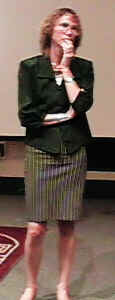 |
 |
The next session on Representation and Formalisation relied a little bit too much on slides with
lots of logic on for my taste (given my fragile health that morning). I do remember that I found Michael Cox's presentation on "An Explicit Representation of Reasoning Failures" very clear. I ended the session by presenting my doctoral student's work (Srinath Perera) on "The Evaluation of a Hierarchical Case Representation using Context Guided Retrieval." I could of course use my editorial privilege to say how well received the presentation was--but hey, why not decide for yourself? You can view the presentation here (requires the PowerPoint Animator) and you can download the paper in postscript format or MS Word97. |
We then broke for lunch and a meeting of the ICCBR-97 programme committee. There were two items on the agenda. The first was to thank Enric Plaza and David Leake for the excellent work they did in organising the conference and the second was to decide on the date and venue for the Third ICCBR conference and on the conference co-chairs. In keeping with tradition (after two conferences) there will be European and American co-chairs. The Third ICCBR will be held in Europe and two venues were proposed. England, at Cambridge University (either St. John's College or Queens College) and Germany, somewhere in Munich. It was agreed that Karl Branting would be the American co-chair, whilst the European chair would depend on the venue decision. The Third ICCBR will be held around the same time as ICCBR-97. The decision will be made by the ICCBR Programme Committee in September, once they have seen details of the English and German proposals. So if you have any strong views email either myself, Michael Richter, or David Leake.
| After lunch the sessions dealt with
Learning & Creative Reasoning. Pietro
Torasso gave an interesting presentation on "A Utility-based Approach to Learning in a Mixed
Case-Based and Model-Based Reasoning Architecture." Now, be honest, you've been wondering "why is that music playing in the background?" Well, the piece of music was composed by a CBR system presented in a paper by Luís Macedo. More information on how CBR can be used to compose music can be found at the SICOM project page, along with MIDI samples of the music (play me the CBR composed tune again). Marin Simina, a colleague of Janet Koldner, gave us an insight into how great inventors, such as Alexander Graham Bell innovate. This paper called "Creative Design: Reasoning and Understanding" interests me because it proposes a problem solving architecture that can put seemingly insoluble problems "on the back burner" until a new (possible analogous) problem suggests a potential solution. This approach seems like it could be useful for autonomous case-based agents. |
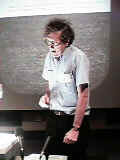 |
This last presentation brought the conference to a close, except for the Panel and Open Discussion on The Future of CBR. The Panelists were:
- Ralph Barletta Inference Corporation
- Kristian Hammond The University of Chicago
- Michael Richter University of Kaiserslautern
- Manuela Veloso Carnegie-Mellon University
Each gave a 5-10 minute presentation. For those of you who were there, you know that the open session became very animated, but let's hear from each of the panelists first.
 |
Ralph Barletta is Inference's Chief Scientist and formerly implemented ReMind for Cognitive Systems. He was and still is therefore very influential in the development of CBR tools. He wants to make CBR part of mainstream software architectures and in particular wants to promote the use of CBR on the Internet for product selection, product support (call deflection from 800 numbers) and intelligent search by using query cases as in the FindMe Systems. He also felt that CBR is useful for data mining because it can make the mined data operational and understandable. Finally, he felt that CBR had a big role to play in knowledge asset management. (As an aside Ralph is planning for much of ReMind's functionality to appear in Inference's CBR4 product in the future.) |
| Kristian Hammond started by saying that he wanted CBR to be in the next Star Trek movie - by which he means we will have succeeded when CBR enters the popular consciousness like neural nets have. He believes that CBR on the web can make CBR more visible to the public. He also maintained that creating applications for frivolous domains such as choosing a restaurant or a video makes CBR more intelligible than serious problem domains such as diagnosing faults in AS7300/S gas turbines. The point being that we need to create demonstrable applications that solve problems that are common sense to people. The long term goal for him is autonomous case-based agents. |  |
 |
Michael Richter agreed that CBR is not well established and that even many computer scientists have not heard of it. He believes though that there is a lack of formalism in our discipline. Many techniques are used ad hoc and with out a more methodical approach we cannot say why a certain approach works in one situation and not in another. Too many research papers are anecdotal - this echoed an observation by David Aha earlier in the week. CBR is currently an art form and it needs to become an engineering discipline before it will be taken seriously. |
| Manuela Veloso agreed with Michael Richter that we needed to know why CBR worked and why it failed. She sees CBR as best in hybrid systems so a problem solver can take over when the CBR component fails to adequately remind (of course this assumes a strong domain theory). She then went on to explain that the future of CBR lay in complex cases and complex case representations. If your cases are "little tables of simple values you don't need CBR, just use C4.5 it will work fine!" (I wish I could do Manuela's accent). Real cases are complex and features are interrelated; this is where CBR can make its contribution because "case representation is the science of CBR." |

It was about this time that the panel opened up to the audience and and the debate (argument) kicked off. I don't remember who started it. However, Manuela, being provocative said "I hate the Web. The information on it is mostly obsolete." This got Kristian's attention who has pinned his future on the success of the Web. He stated again that it is innovative and a good way to get visibility for CBR. The debate then move on to a disagreement between whether "toy" problems are useful or should researchers use "real" data for their studies. Manuela and Kristian, now keen to disagree passionately on any point of principle, took totally opposite views. Manuela stating that toy problems provide good scientific results in a controlled way whilst applications are not science. Kristian disagreed stating that toy problems were a waste of time and real findings "only" came from solving real problems.
In a way I agree with Manuela, since I have found that research students can be swamped by volumes of real data and are not able to see the wood for the trees as it were. Also working in a controlled environment does let one explore the limitations and strengths of an approach better. However, conversely there is no doubt that not having enough case data also stifles a lot of research. The availability of case data brought us to the subject of case repositories (like the UCI ML data sets). David Aha believes that the ML data sets have stifled creativity, even though he helped create them. It was generally agreed that the CBR community should not get into benchmarking its techniques in the same way that the ML community has done, but that there was a role nonetheless for a case-base repository. (If you are interested AI-CBR is trying to establish a case-archive to which you can contribute case-bases or links to case-bases).
After this everyone started to agree with each other (even Manuela and Kristian) and it was agreed that to explain CBR to people (even other researchers) you had to simplify your applications. This is an abstraction process that makes the results generalisable and meaningful.
The conference ended with many people going on to AAAI-97 which had just started "down the hill" and others going on vacation in New England. I did a bit of both.
See you all at the next ICCBR in 1999 or perhaps sooner at the 3rd. UK CBR Workshop, ECAI-98, or the European CBR Workshop in Dublin. Please don't forget if you want to add your comments on the conference of link a downloadable paper please email me.
![]()

